We rendezvoused with Dan in Calgary AB. It's midway between our two homes and the perfect place
to spend quality time together while visiting
Alberta's famous tourist sites. Mid summer is the perfect time to visit - the weather is balmy, the vegetation is lush
and the Canadian Rockies are awesome. We often saw wildlife, though some native
species surprised us.
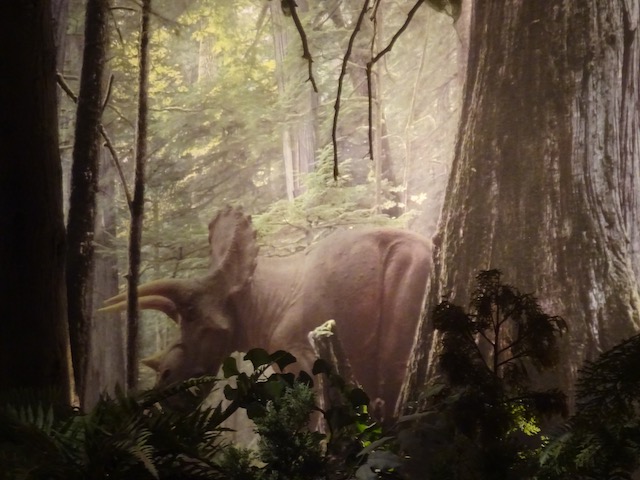
A Native Species of Alberta?
News & Notes
We chose Alberta because it is home to the Royal Tyrrell Museum, a world class natural history institute emphasizing paleontology. (We visited in 2017 and sent a postcard.) Our favorite paleontologist gave us the all-day tour, and like previous Dan Seminars this one was fascinating and AWEsome.
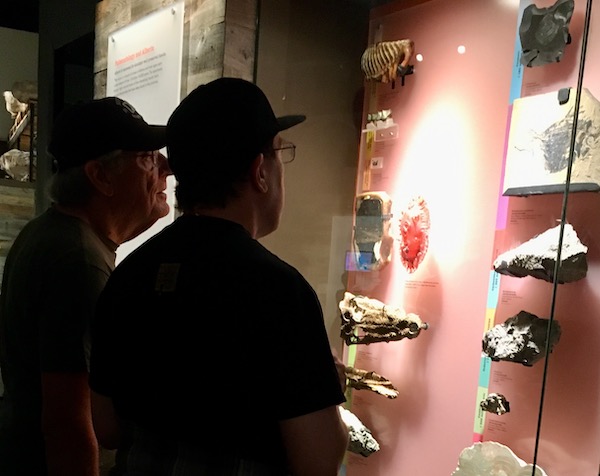
L & D Review Some Fact About the Evolution of Organisms
Amazing fossils can be found almost everywhere in Alberta, explaining the names of dinosaurs like Albertasaurus and Edmontosaurus. It also explains why the Tyrrell's collection is so spectacular. Tyrrell's exhibits have the familiar posed dinosaurs we've all seen, but they also show other specimens partially exposed, often in a dramatic form. Most Tyrrell specimens are original (not casts) and many are complete. Some fossils are beautiful, some fossils are delicate, and some fossils are a meter across! Awesome!
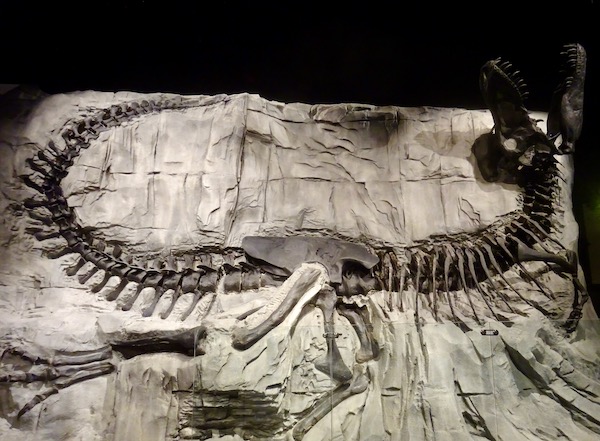
Not a T. rex, But a Bro ... Less Fearsome When Still Stuck in Rock
One very fun stop was Head Smashed-In Buffalo Jump, a Canadian historical site where in the past the Blackfoot people stampeded buffalo (Bison bison) off a cliff, killing them for food. Legend says a brave, too young to participate in scaring the buffalo off the cliff, hid in the crevices of the cliff to watch, but was accidentally killed during the stampede. On our last visit hiking was closed (due to a cougar sighting), so happily, this year we could take the hike out through beautiful prairie to the cliff face -- no buffalo, but a fat marmot, definitely alive (and definitely native!)
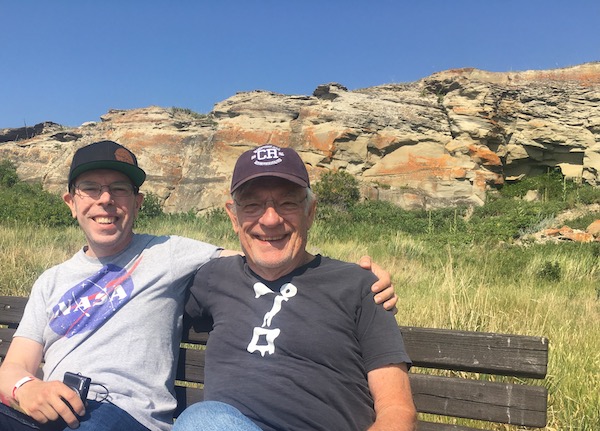
The Cliff The Blackfoot Indians Stampeded Buffalo Over
The museum displays artifacts found at the site among the zillions of bones that had accumulated over the millenia. The Blackfoot shot any buffalo that didn't die in the fall, so it wouldn't return to the herd and warn them. Most interesting was a "Winter Count" hide, the calendar of the local Peigan Blackfoot band. Each winter a pictogram is entered representing the most significant event that year. Notice (a) the tiny dots in a dome near teepees near the center, recording "big smallpox scare", and (b) the last pictogram upper right, recording "when the buffalo disappeared".
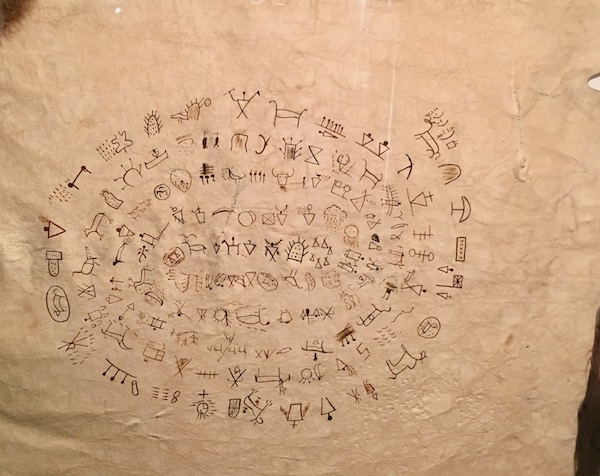
Peigan Blackfoot Winter Count Hide, Calendar for 1764 - 1879
As part of a celebration at HS-iBJ, the local Peigan Blackfoot band presented an hour long show of chants and dances. After a multicultural multi-flag welcome, a dozen elaborately dressed dancers, backed by four guys perfectly in sync beating a drum, performed traditional dances as the MC gave an explanation. Among the dancers were some who'd won Canada-wide contests the week before. Very IMPRESSIVE.
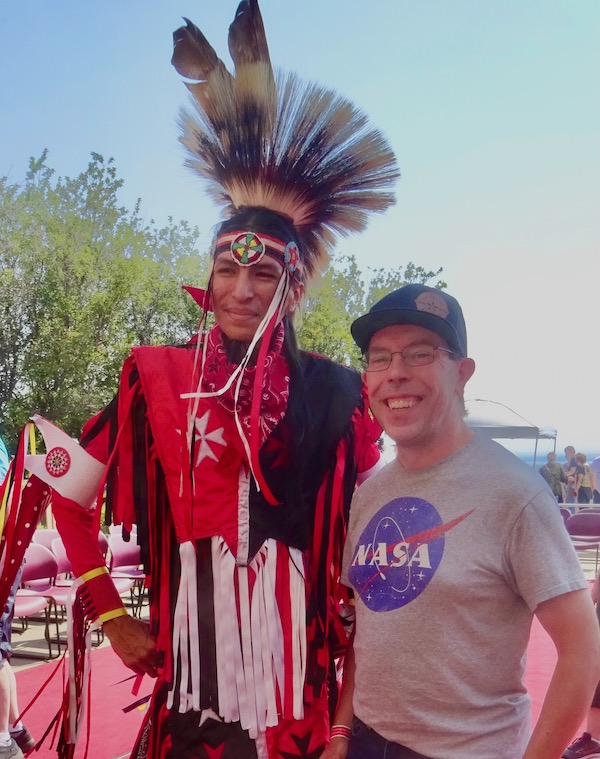
Dan Should Have Asked To Trade Hats
Maybe it was just that we had a geologist with us, but we spotted two pretty amazing geological sites.
-- The Okotoks Erratic is a big rock that was carried to southern Alberta by a glacier. Yup. A glacier toted the quartzite monster from Mt. Edith Cavell in Jasper National Park that's 286 miles back up in the mountains! Some Trip! Some Glacier! The local Blackfoot Indians, not concerned about where the Okotoks Erratic came from, invented a cute legend to explain why it's in two parts.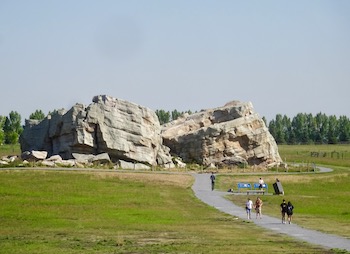
-- Franks Slide obliterated the mining town of Franks AB in April 1903 when Turtle Mountain gave way. Wikipedia gives the particulars (44 million cubic meters or 120 million tons), but it is EXTREMELY sobering to pass by barn-size rocks that tumbled up the opposite hill as the "stone surf" swept across the valley. Although the slide is 120 years old, it feels like the stone is still settling into place, not quite stable.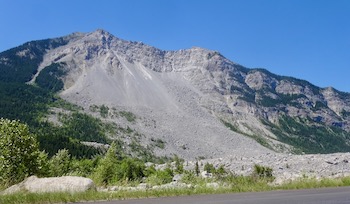
On a quick trip from Calgary to Banff, we learned by mid-morning that Lake Louise was "closed". Presumably, the water was still there, but the parking capacity was saturated. No worries. It's a beautiful part of the world, so we took a hike. As we passed the "Beware of Bears" signs, we guessed the local tourism boosters had put them up just to add excitement to the unparalleled beauty.
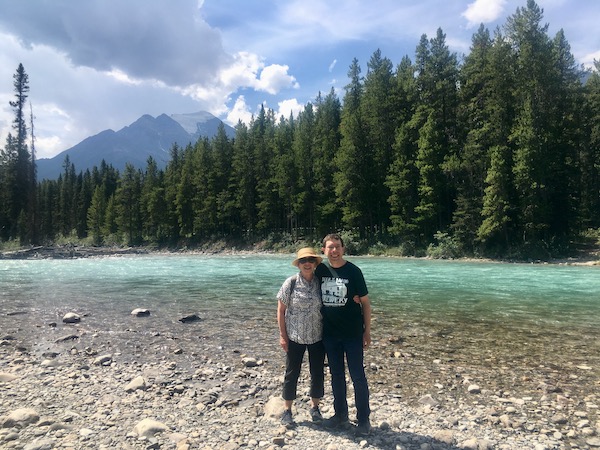
J and D Along the Bow River Near Banff
We squeezed in a visit with Jim and Julie in Libby MT both before and after going to Calgary.
Finally, that Triceratops in the first picture, apparently wandering around the Albera forest, is from a mural just inside the entry to the Royal Tyrrell Museum. According to our very authoritative source, it is probably T. horridus, once a native of the Calgary area.




